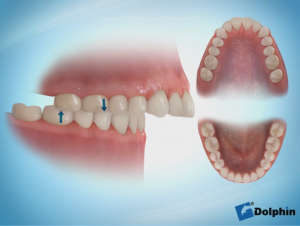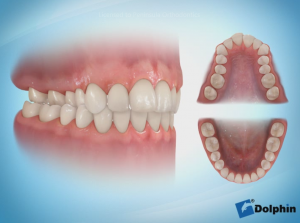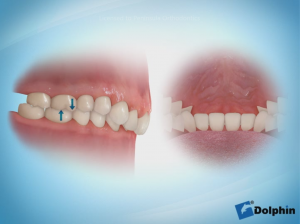One of the lesser known aspects of orthodontics is the ability to correct not only the alignment of the teeth, but the alignment of the bite. The upper and lower teeth are designed to contact each other in a certain way, giving us the ability to slice, tear and crush our food; failure to do so in a harmonious manner can not only make eating difficult, but such malocclusions can cause teeth to wear prematurely, leading to further functional difficulty, costly repairs, or unsightly appearance.
In an ideal occlusion (meeting of the teeth) the lower teeth sit just inside the upper teeth with light, even contact so the biting force is distributed across all of the teeth. A person’s bite can be assessed in many ways, but essentially there are three components – anterior-posterior (front-back), horizontal (left-right) and vertical (up-down). Let’s look at some discrepancies that can occur in any/all of these three aspects.
Anterior-posterior
This is the most visually evident discrepancy, and the one which most people are aware of. It is caused by one of the jaws not growing equally with the other, resulting in one jaw being too far forward or back in relation to the other. This often makes the person ‘look’ like the one of the jaws is protruding (either upper or lower). This measurable distance is referred to as overjet (a reverse overjet occurs when the top teeth sit inside the lower teeth).
Horizontal
As previously mentioned, the lower teeth ideally sit just inside the upper teeth, thus the upper arch is slightly wider to accommodate this arrangement. Due to the individual differences in the way people grow this does not always occur, sometimes resulting in an upper arch that is narrower than the lower. This situation, where the top teeth sit inside of the lower teeth is referred to as a crossbite, and can occur on one or both sides. In some circumstances where the upper teeth are too wide for the lower teeth, there is such a horizontal discrepancy they completely fail to contact and they come together like scissors; this is aptly referred to as a scissor-bite.
Vertical
This relationship refers to the amount of vertical overlap the upper and lower teeth have (overbite). This is ideally 2-3 millimetres, but can range due to growth patterns or particular unfavourable habits during the developmental years. Individuals with increased overlap are considered to have a ‘deep’ bite; in the worst circumstances this can cause the lower front teeth to contact traumatically on the roof of the mouth or upper front teeth. Conversely, individuals with reduced or no overlap can have an ‘open bite’ where some or many of the upper and lower teeth to not contact, even when biting together. This has obvious implications for biting into food and speech. Habits such as thumb sucking often cause this type of situation.
There are several ways these jaw discrepancies can be addressed depending on the severity, patient’s growth pattern, and patient’s age. If you’re concerned about your or your child’s bite, come in and see us!





Recent Comments